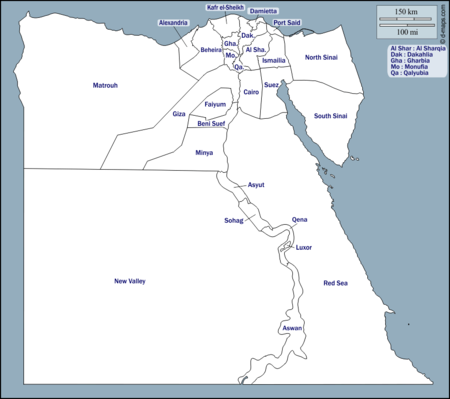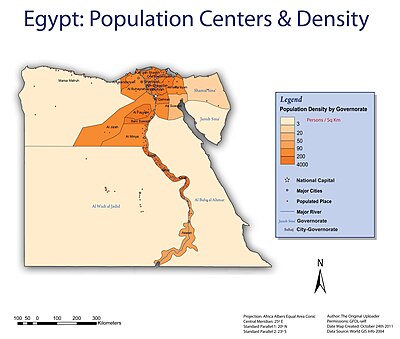|
Subdivisions of Egypt
Egypt is divided, for the purpose of public administration, according to a three-layer hierarchy and some districts are further subdivided, creating an occasional fourth layer. It has a centralized system of local government officially called local administration as it is a branch of the Executive.[1] The top-level of the hierarchy are 27 governorates (singular: محافظة muḥāfẓa, plural: محافظات muḥāfẓat).[2] A governorate is administered by a governor, who is appointed by the President of Egypt and serves at the president's discretion. Governors have the civilian rank of minister and report directly to the prime minister, who chairs the Board of Governors (maglis al-muhafzin) and meets with them on a regular basis.[3][4] The Minister of Local Development coordinates the governors and their governorate's budgets.[5] The second-level, beneath and within governorates, are marakiz (singular: مركز markaz, plural: مراكز marakiz) or aqsam (singular: قسم qism, plural: أقسام aqsam). The third-level is composed of districts (singular: حي ḥay, plural: أحياء aḥya') and villages (singular: قرية qarya, plural: قرى qura). There is a governing structure at each of these levels.[6][7] Districts may be further divided into sub-districts as a fourth level. There are also seven economic regions used for planning purposes, defined by the General Organization for Physical Planning (GOPP). OverviewEgypt generally has three tiers of local administration units as per Article 1 of the Local Administration Law where each unit has an appointed head,[1] and one economic level that does not have any administrative duties:[8] 0. Economic regions (non administrative, comprising governorates)
In addition to these tiers are New Urban Communities, which are satellite cities that are built and operated by the national level New Urban Communities Authority (NUCA). Its chairman, the Minister of Housing, Utilities and Urban Communities issues planning permits and oversees the communities, while the appointed city agency heads issue building permits and run the day-to-day affairs of functioning towns.[9] These 'cities' are represented in the local administration hierarchy as qisms affiliated to the nearest city proper (See for example Badr, Shorouk and New Cairo). While NUCA is legally obliged to transfer these communities to mainstream local administration once they are developed, none have been since its inception in 1979.[9] The other exception are new villages built by the Ministry of Agriculture's General Authority for Rehabilitation Projects and Agricultural Development (GARPAD) in its desert land reclamation schemes, which are initially under its jurisdiction and should eventually be transferred to local authorities.[10] At the highest tier, there are three city-state governorates, Cairo, Port Said, and Suez, where the governor is also head of the city and lower units are 100% urban. Alexandria is a quasi -city-state also with a merged city-governorate unit, though with one rural county (markaz). The other 23 governorates are formed of counties (marakiz, sing. markaz) composed of one city acting as the local administrative capital, overseeing other smaller cities (actually towns) as well as rural units (al-wihdat al-rifiyah) that are villages.[11] The county-city heads (raies markaz wa madina) are appointed by the governor, where one county-city serves as the governorate capital and seat of the governor. Two new governorates were created in April 2008: Helwan and 6th of October.[12] In April 2011, however, the 6th of October and Helwan governorates were again incorporated into the Giza and Cairo Governorates, respectively.[13] Luxor was created in December 2009, to be the 29th governorate of Egypt, but with the abolition of the 6th of October and Helwan governorates, the number of governorates has decreased to 27.[14] HistoryBefore the 1952 Egyptian revolution, state penetration of the rural areas was limited by the power of local notables. Under Nasser, land reform reduced those notables' socioeconomic dominance, and the peasants were incorporated into cooperatives which transferred mass dependence from landlords to the government. The extension of officials into the countryside permitted the regime to bring development and services to the village. The local branches of the ruling party, the Arab Socialist Union (ASU), fostered a certain peasant political activism and coopted the local notables — in particular the village headmen — and checked their independence from the regime.[15] State penetration did not retreat under Sadat and Mubarak. The earlier effort to mobilize peasants and deliver services disappeared as the local party and cooperative withered, but administrative controls over the peasants remained intact. The local power of the old families and the headmen revived but more at the expense of peasants than of the state. The district police station balanced the notables, and the system of local government (the mayor and council) integrated them into the regime.[15] Until 1979, local government enjoyed limited power in Egypt's highly centralized state. Under the central government, there were twenty-six governorates (27 today), which were subdivided into counties (In Arabic: مركز markaz "center", plural: مراكز marākiz), each of which was further subdivided into towns or villages.[15] At each level, there was a governing structure that combined representative councils and government-appointed executive organs headed by governors, district officers, and mayors, respectively. Governors were appointed by the president, and they, in turn, appointed subordinate executive officers. The coercive backbone of the state apparatus ran downward from the Ministry of Interior through the governors' executive organs to the district police station and the village headman.[15] Sadat took several measures to administratively decentralize power to the provinces and towns, with limited fiscal and almost no political decentralisation. Governors acquired more authority under Law 43/1979,[1] which reduced the administrative and budgetary controls of the central government over the provinces. The elected councils acquired, at least formally, the right to approve or disapprove the local budget. In an effort to reduce local demands on the central treasury, local government was given wider powers to raise local taxes. Local representative councils became vehicles of pressure for government spending, and the soaring deficits of local government bodies had to be covered by the central government. Local government was encouraged to enter into joint ventures with private investors, and these ventures stimulated an alliance between government officials and the local rich that paralleled the infitah alliance at the national level. Under president Hosni Mubarak's rule (1981-2011), some scholars believed decentralization and local autonomy was achieved, and local policies often reflected special local conditions. Thus, officials in Upper Egypt often bowed to the powerful Islamic movement there, while those in the port cities struck alliances with importers."[15] However, others found local governance proved impotent, with parliamentarians reduced to the roles of local councillors, lobbying at the parliamentary level for basic local services, while the elected Local Popular Councils (LPC) had a parallel ceremonial role to the appointed Local Executive Councils (LEC) that managed the local departments.[16] Elections of the LPCs have also been observed to be fraudulent where the ruling National Democratic Party NDP won 95 percent of local council seats during the last election in 2008, and 84 percent of the seats were walkovers.[17] After Mubarak was deposed by the popular uprising of January 2011, parliament and local councils were dissolved pending the writing of a new constitution. The short-lived 2012 constitution and the current 2014 version gave wider local power through more decentralization.[4] However, till the end of 2022, it has not been implemented as the government has drawn out the process of drafting a new local administration law leaving LPC seats vacant for over a decade.[18][17] Governorates Egypt is divided into 27 governorates (muhāfazāt) and each has a capital and at least one city.[19] Each governorate is administered by a governor, who is appointed by the President of Egypt and serves at the president's discretion. Most governorates have a population density of more than one thousand per km2, while the three largest have a population density of less than two per km2.[20] The governorates of Egypt are:
Municipal divisions  At the municipal-level are markaz, kism, police-administered areas, and new cities. Generally, rural areas are divided into markaz whereas urban areas are divided into kism. As of 2013, there were 351 subdivisions, of which 177 were kism, 162 markaz, 9 new cities, and 3 police-administered areas. There are also unorganized areas in the Alexandria, Aswan, Asyut, Beheira, Beni Suef, Cairo, Dakahlia, Damietta, Faiyum, Giza, Ismailia, Kafr El Sheikh, Luxor, Minya, Port Said, Qalyubia, Qena, Sharqia, Sohag, and Suez governorates.[24][25]
Submunicipal divisionsThe village is the smallest local unit in rural communities, and is the equivalent of a district in urban areas. However, villages differ from each other in terms of legal status. The heads of villages or districts are appointed by the respective governors.[26] In addition to this, districts are occasionally further divided into sub-district neighborhoods called sheyakha in rural areas, or residential districts (singular: حي سكني ḥay sakani, plural: أحياء سكنية aḥya' sakaniya) in urban areas.[27] DemographicsUrban and rural populationsData taken from CAPMAS:[21]
Population density Data taken from CAPMAS:.[21] Information for population is in thousands, pop density - persons/km2 and area is in km2.
See also
References
External links
|
||||||||||||||||||||||||||||||||||||||||||||||||||||||||||||||||||||||||||||||||||||||||||||||||||||||||||||||||||||||||||||||||||||||||||||||||||||||||||||||||||||||||||||||||||||||||||||||||||||||||||||||||||||||||||||||||||||||||||||||||||||||||||||||||||||||||||||||||||||||||||||||||||||||||||||||||||||||||||||||||||||||||||||||||||||||||||||||||||||||||||||||||||||||||||||||||||||||||||||||||||||||||||||||||||||||||||||||||||||||||||||||||||||||||||||||||||||||||||||||||||||||||||||||||||||||||||||||||||||||||||||||||||||||||||||||||||||||||||||||||||||||||||||
